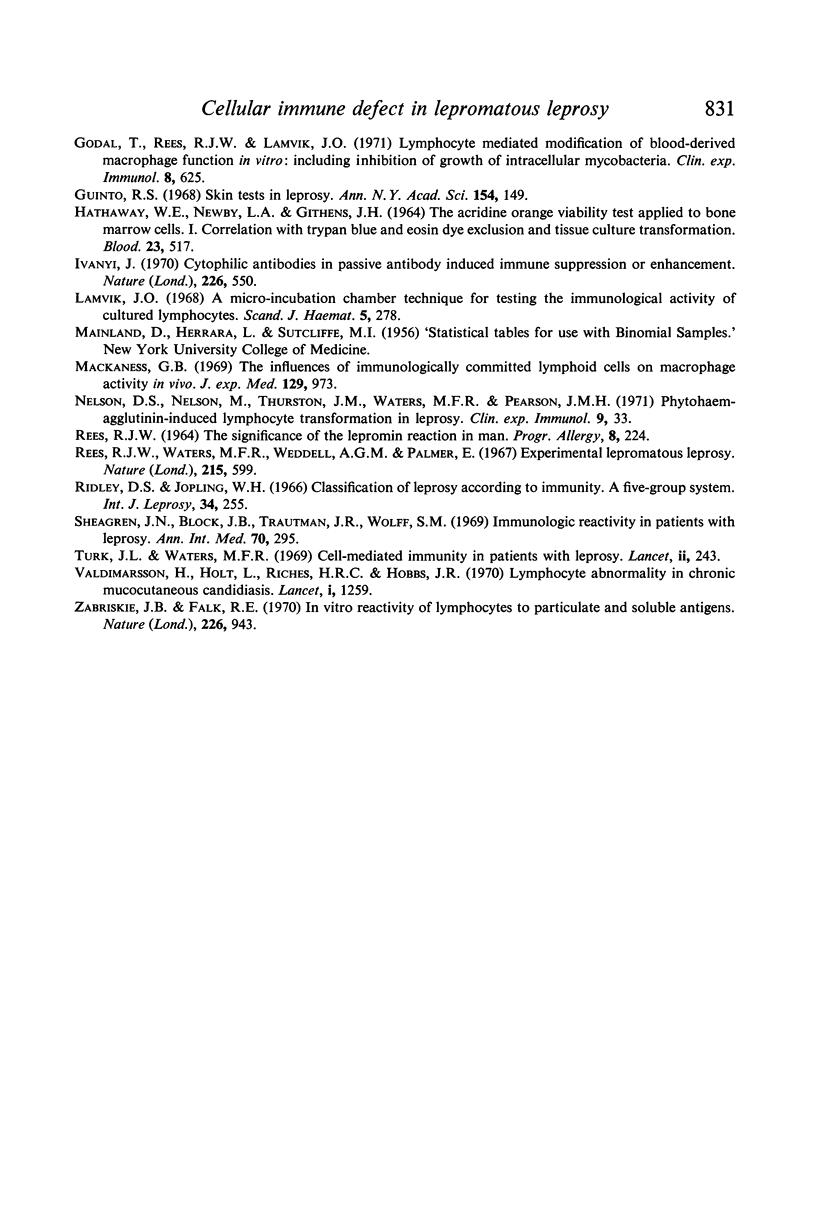Abstract
The blastogenic response of leucocyte cultures from patients with tuberculoid and lepromatous leprosy has been studied. The leucocytes from the two groups were studied simultaneously and cultivated in the same pool of normal human serum. While the leucocytes from twenty-eight tuberculoid patients responded quite strongly to Mycobacterium leprae after 7 days of culture (average lymphocyte transformation 11·1%), there was a complete lack of response in similar cultures from twenty-seven lepromatous patients (average 0·1% transformed cells). These results were confirmed by studies on cellular incorporation of 3H-thymidine in the cultures from four tuberculoid and four lepromatous patients.
This lack of response was quite specific as leucocytes from several lepromatous patients responded to BCG. Furthermore, four patients with both lepromatous leprosy and tuberculosis responded as strongly to BCG and PPD as tuberculous patients without leprosy. In the mixed leucocyte reaction, between two lepromatous or two tuberculoid patients respectively, the lepromatous cells responded well (average 15·0%) and comparably to tuberculoid cells (average 12·1%).
The blastogenic response of purified lymphocytes to M. leprae revealed a similar pattern, i.e. the tuberculoid cells responded well, while again there was a lack of response in the lepromatous group.
It is concluded that the lepromatous patients lack circulating lymphocytes responding to M. leprae, indicating that their immunological defect as observed in the present study has features in common with immunological tolerance.
Full text
PDF










Selected References
These references are in PubMed. This may not be the complete list of references from this article.
- Barbieri T. A., Correa W. M. Human macrophage culture. The leprosy prognostic test (LPT). Int J Lepr Other Mycobact Dis. 1967 Jul-Sep;35(3):377–381. [PubMed] [Google Scholar]
- Beiguelman B. Leprosy and genetics. A review of past research with remarks concerning future investigations. Bull World Health Organ. 1967;37(3):461–476. [PMC free article] [PubMed] [Google Scholar]
- Boak J. L., Kölsch E., Mitchison N. A. Immunological tolerance and inhibition by hapten. Antibiot Chemother. 1969;15:98–109. doi: 10.1159/000386774. [DOI] [PubMed] [Google Scholar]
- Bryceson A. D. Diffuse cutaneous leishmaniasis in Ethiopia. I. The clinical and histological features of the disease. Trans R Soc Trop Med Hyg. 1969;63(6):708–737. doi: 10.1016/0035-9203(69)90116-3. [DOI] [PubMed] [Google Scholar]
- Canales L., Middlemas R. O., 3rd, Louro J. M., South M. A. Immunological observations in chronic mucocutaneous candidiasis. Lancet. 1969 Sep 13;2(7620):567–571. doi: 10.1016/s0140-6736(69)90264-5. [DOI] [PubMed] [Google Scholar]
- Chilgren R. A., Meuwissen H. J., Quie P. G., Good R. A., Hong R. The cellular immune defect in chronic mucocutaneous candidiasis. Lancet. 1969 Jun 28;1(7609):1286–1288. doi: 10.1016/s0140-6736(69)92223-5. [DOI] [PubMed] [Google Scholar]
- Dierks R. E., Shepard C. C. Effect of phytohemagglutinin and various mycobacterial antigens on lymphocyte cultures from leprosy patients. Proc Soc Exp Biol Med. 1968 Feb;127(2):391–395. doi: 10.3181/00379727-127-32698. [DOI] [PubMed] [Google Scholar]
- Dresser D. W., Mitchison N. A. The mechanism of immunological paralysis. Adv Immunol. 1968;8:129–181. doi: 10.1016/s0065-2776(08)60466-6. [DOI] [PubMed] [Google Scholar]
- Dumonde D. C., Wolstencroft R. A., Panayi G. S., Matthew M., Morley J., Howson W. T. "Lymphokines": non-antibody mediators of cellular immunity generated by lymphocyte activation. Nature. 1969 Oct 4;224(5214):38–42. doi: 10.1038/224038a0. [DOI] [PubMed] [Google Scholar]
- Gaugas J. M. Enhancing effect of antilymphocytic globulin on human leprosy infection in thymectomized mice. Nature. 1968 Dec 21;220(5173):1246–1248. doi: 10.1038/2201246a0. [DOI] [PubMed] [Google Scholar]
- Godal T., Rees R. J. Fate of Mycobacterium leprae in macrophages of patients with lepromatous or tuberculoid leprosy. Int J Lepr Other Mycobact Dis. 1970 Oct-Dec;38(4):439–442. [PubMed] [Google Scholar]
- Godal T., Rees R. J., Lamvik J. O. Lymphocyte-mediated modification of blood-derived macrophage function in vitro; inhibition of growth of intracellular mycobacteria with lymphokines. Clin Exp Immunol. 1971 Apr;8(4):625–637. [PMC free article] [PubMed] [Google Scholar]
- Guinto R. S. Biology of the mycobacterioses. Skin tests in leprosy. Ann N Y Acad Sci. 1968 Sep 5;154(1):149–156. doi: 10.1111/j.1749-6632.1968.tb16705.x. [DOI] [PubMed] [Google Scholar]
- HATHAWAY W. E., NEWBY L. A., GITHENS J. H. THE ACRIDINE ORANGE VIABILITY TEST APPLIED TO BONE MARROW CELLS. I. CORRELATION WITH TRYPAN BLUE AND EOSIN DYE EXCLUSION AND TISSUE CULTURE TRANSFORMATION. Blood. 1964 Apr;23:517–525. [PubMed] [Google Scholar]
- Iványi J. Cytophilic antibodies in passive aibody induced immune suppression or enhancement. Nature. 1970 May 9;226(5245):550–551. doi: 10.1038/226550b0. [DOI] [PubMed] [Google Scholar]
- Lamvik J. O. A micro-incubation chamber technique for testing the immunological activity of cultured lymphocytes. Scand J Haematol. 1968;5(4):278–286. doi: 10.1111/j.1600-0609.1968.tb01749.x. [DOI] [PubMed] [Google Scholar]
- Mackaness G. B. The influence of immunologically committed lymphoid cells on macrophage activity in vivo. J Exp Med. 1969 May 1;129(5):973–992. doi: 10.1084/jem.129.5.973. [DOI] [PMC free article] [PubMed] [Google Scholar]
- Nelson D. S., Nelson M., Thurston J. M., Waters M. F., Pearson J. M. Phytohaemagglutinin-induced lymphocyte transformation in leprosy. Clin Exp Immunol. 1971 Jul;9(1):33–43. [PMC free article] [PubMed] [Google Scholar]
- Rees R. J., Waters M. F., Weddell A. G., Palmer E. Experimental lepromatous leprosy. Nature. 1967 Aug 5;215(5101):599–602. doi: 10.1038/215599a0. [DOI] [PubMed] [Google Scholar]
- Ridley D. S., Jopling W. H. Classification of leprosy according to immunity. A five-group system. Int J Lepr Other Mycobact Dis. 1966 Jul-Sep;34(3):255–273. [PubMed] [Google Scholar]
- Sheagren J. N., Block J. B., Trautman J. R., Wolff S. M. Immunologic reactivity in patients with leprosy. Ann Intern Med. 1969 Feb;70(2):295–302. doi: 10.7326/0003-4819-70-2-295. [DOI] [PubMed] [Google Scholar]
- Turk J. L., Waters M. F. Cell-mediated immunity in patients with leprosy. Lancet. 1969 Aug 2;2(7614):243–246. doi: 10.1016/s0140-6736(69)90009-9. [DOI] [PubMed] [Google Scholar]
- Valdimarsson H., Holt L., Riches H. R., Hobbs J. R. Lymphocyte abnormality in chronic mucocutaneous candidiasis. Lancet. 1970 Jun 13;1(7659):1259–1261. doi: 10.1016/s0140-6736(70)91742-3. [DOI] [PubMed] [Google Scholar]
- Zabriskie J. B., Falk R. E. In vitro reactivity of lymphocytes to particulate and soluble antigens. Nature. 1970 Jun 6;226(5249):943–945. doi: 10.1038/226943a0. [DOI] [PubMed] [Google Scholar]


